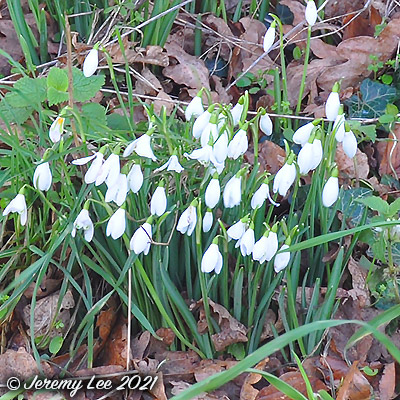
 |
|
Scientific Classifications explained » Amphibians » Ants » Aphids » Bees » Beetles » Birds » Bugs » Butterflies » Caterpillars » Damselflies » Dragonflies » Earwigs » Flies » Frog/Leafhoppers » Fungi » Galls » Grasshoppers » Harvestmen » Hoverflies » Lacewings » Ladybirds » Leaf Mines » Lichens » Mammals » Millipedes » Mosses » Moths » Sawflies » Slugs » Snails » Spiders » Trees & Shrubs » Wasps » Wild Flowers » Woodlice » PB |
UK Nature > Wild Flowers > White Wild Flowers > Galanthus nivalis

Scientific Name: Galanthus nivalis Common Name: Snowdrop Galanthus nivalis, more commonly known as the Snowdrop, is one of the first signs of spring. While not native to these shores, these hardy flowers have become a familiar indicator of the shifting seasons and a sure sign that warmer weather is on its way. Standing around 7–15 cm tall, snowdrops have white bell-shaped flowers at the end of an erect flowering stem with two to three leaves. The leaves are narrow to linear in shape, smooth and dull grey-green in colour. The flowers lack petals and are composed of six white flower segments known as tepals (they look like petals). The inner three tepals are smaller and have a notch in the tip, with a green upturned ‘v’ pattern visible. Snowdrops are found across the UK. They favour damp soil and are often found in broadleaved woodland and along riverbanks, but can also be seen in parks, gardens, meadows and scrub. The species normally flowers in January and February, but there are an increasing number of December flowerings being recorded and even the occasional November sighting. |
|

https://www.uknature.co.uk is a website dedicated to showing the immense diversity of UK nature and wildlife. Our vast range of habitats, from lowland arable to snow covered mountains, from storm-ravaged coastlines to peaceful inland freshwater lakes and rivers, from dry, sandy heaths to deciduous and coniferous forests, all these habitats contribute to the abundance of UK nature. We have wild birds in huge numbers either residing or visiting our shores (597 recorded species as at July 2013) and we must also not forget the humble back garden with its grass lawns, flower beds filled with nectar rich flowers, shrubs and trees, all designed to attract huge numbers of insects such as bees, moths, butterflies and hoverflies; and finally the small ponds which provide safe havens for frogs, toads, newts and even slow worms and grass snakes. www.uknature.co.uk is the showcase for my personal passion, photographing uknature in all its glory. I sincerely hope you all enjoy the fruits of my labours. This site and all images contained therein is © Jeremy Lee 2004 - 2025. All Rights Reserved. Site design by Jeremy Lee. Site development & IT Support by Stuart Lee. |